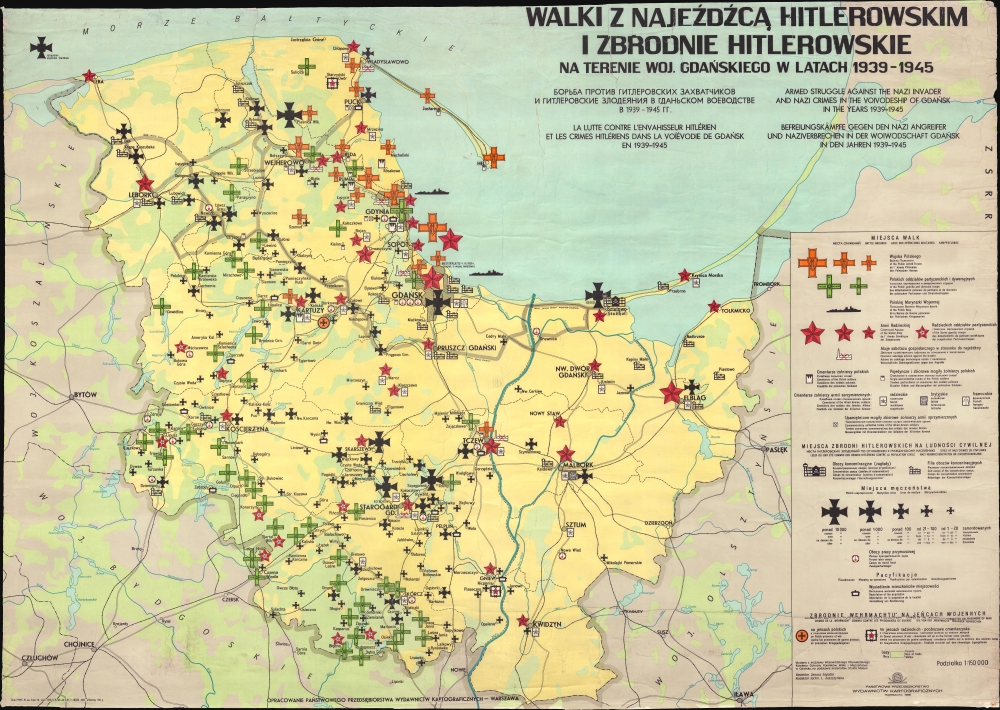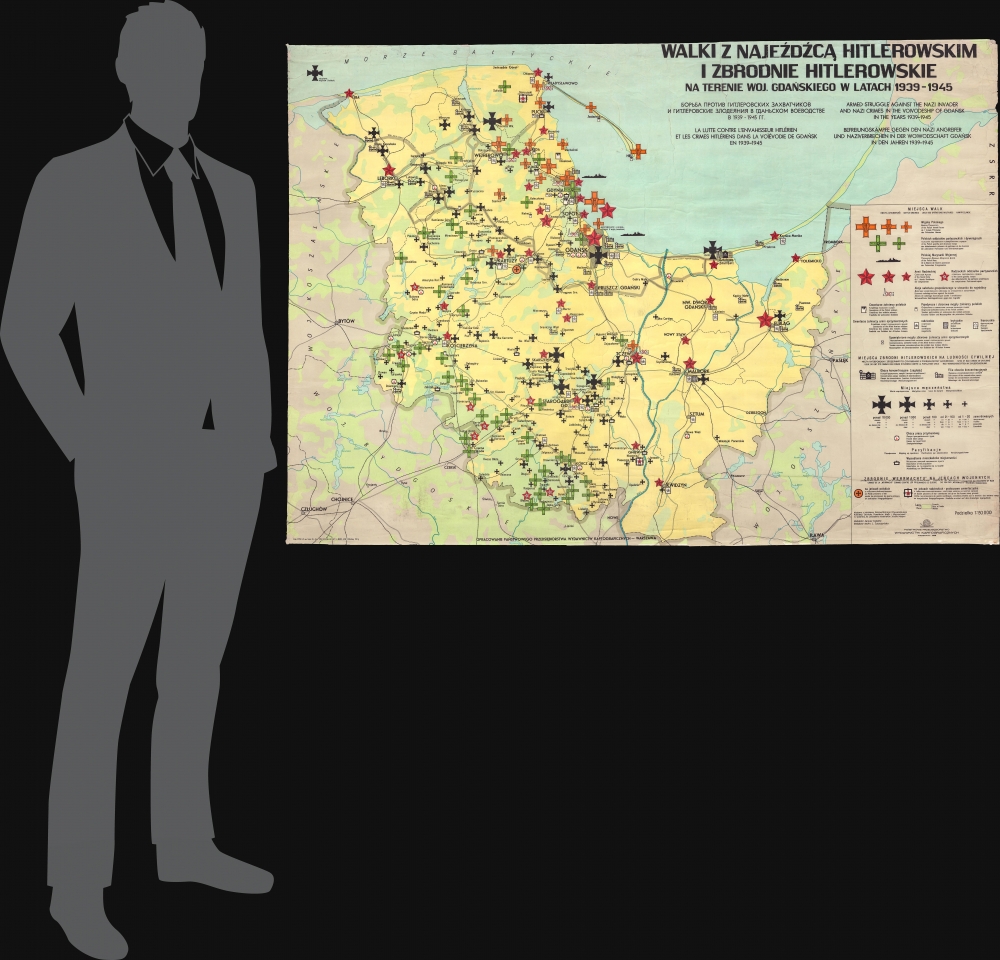1968 Polish Multilingual Map of Nazi Crimes in the Voivodeship of Gdańsk, Poland
Gdanskiego-walki-1968$3,500.00

Title
Walki z Najeźdźcą Hitlerowskim i Zbrodnie Hitlerowskie na Terenie Woj. Gdańskiego w Latach 1939 - 1945. Armed Struggle Against the Nazi Invader and Nazi Crimes in the Voivodeship of Gdańsk in the Years 1939 - 1945.
1968 (dated) 37.75 x 53 in (95.885 x 134.62 cm) 1 : 150000
1968 (dated) 37.75 x 53 in (95.885 x 134.62 cm) 1 : 150000
Description
A chilling 1968 Polish wall map chronicling Hitler's war crimes and the fight against the invasion and occupation of the voivodeship of Gdańsk. It was published by the Provincial Citizens' Committee for the Protection of Monuments of Struggle and Martyrdom in Gdańsk. It is ever more poignant in the light of modern revisionist historical research that has re-evaluated the Polish role in the Holocaust, as well as efforts by the current Polish government to legislate and control the historical record. All text on this piece is in Polish, Russian, English, French, and German.
This derives from the necessity of kowtowing to Soviet censorship. Although the Nazis and Hitler specifically are demonized, there is no clear anti-German bias. The map appears to have been produced from impartial sources to represent Nazi war crimes accurately. Through this and similar maps, much of the current leadership of Poland, who grew up in the Soviet Era, received their education and understanding of the Holocaust.
Today, historical revisionism regarding Poland's role in the Holocaust encompasses a contentious area of public discourse. The narrative traditionally highlights Poland as a nation under German occupation, with Poles risking their lives to help Jews. This happened. However, current scholars are bringing to light instances where some Poles collaborated with Nazis or participated in the persecution of Jews. This revisionism has sparked intense debate, influenced by broader considerations of national identity, memory, and responsibility. Current efforts by the Polish government to legislate how the Holocaust is remembered, particularly laws making it illegal to accuse the Polish nation of complicity in the Holocaust, have further intensified these debates, highlighting the ongoing struggle over the historical memory.
Emphasizing Nazi Crimes
The map depicts the entire voivodeship of Gdańsk and some of the surrounding region. Icons detail Nazi crimes. One concentration camp, the notorious Stutthof, appears, along with dozens of satellite camps throughout the voivodeship. The number of sub-camps in this region is truly astonishing. Black German iron crosses mark mass execution sites, and the size of the cross corresponds to the magnitude of the massacre. The largest crosses, such as those in Gdańsk, Sztutowo (Stutthof), and Piaśnica Wlk., symbolize massacres of over 10,000 individuals. The cross in the Baltic Sea remembers the thousands of Stutthof prisoners who drowned while being transferred to camps in Germany and elsewhere. Other symbols mark forced labor camps and towns whose population was entirely deported. Crimes committed by the Nazis against Polish and Soviet prisoners of war are also marked.Fighting the Invasion and Occupation
The other symbols present highlight actions taken against the Nazis. Orange crosses mark the battlegrounds of the Polish Armed Forces, while green crosses mark the battle sites of Polish guerrilla forces. Red stars mark Red Army and Soviet guerrilla battle sites. Small symbols with red 'x's through them highlight locations of sabotage actions taken against the Nazis. Other symbols mark cemeteries and graves for Polish, Soviet, British, and French forces buried in Poland. A special symbol is used to mark commemoratory collective tombs of Allied Armies soldiers.Gdańsk and World War II
After World War I (1914 - 1918), Gdańsk was known as Danzig. Under the Treaty of Versailles, the city was declared the Free City of Danzig, made a city-state, and put under the oversight and protection of the League of Nations. The new city-state included the Port of Danzig and nearly 200 small communities in its immediate vicinity. This state of affairs lasted from 1920 until 1939. An imposed union bound Danzig to Poland through ties of defense, foreign policy, railway and postal connections, and a customs union. The city's ethnic German majority resented the forced connection with Poland, and city workers showed their resentment of the Poles through labor strikes meant to damage the Polish economy. This led Poland to invest in Gdynia, another port on the Baltic Sea, to avoid becoming dependent on a hostile city-state. Nazi supporters gained a majority in the city's senate by 1936 and pushed for even stronger ties with Germany. Nazi Germany invaded Poland on September 1, 1939, beginning World War II, and Danzig was the first city they invaded. The first shots of the war, fired from a German battleship, fell on Danzig. That day, September 1, 1939, the city's government officially declared Danzig part of Germany.Through a Soviet Lens
When this map was issued, Poland was firmly part of the Soviet Eastern Bloc. While the map is sensitive to the plight of Poles in general and especially the Soviets who suffered under the Nazis, this map is representative of the Soviet party line regarding 'Hitler's atrocities' - that all nations suffered, fought, and won equally. Aside from the Soviets and Poles, there is no mention of any specific ethnic or religious group. There also is naturally no mention of the Soviet Union's repressive actions and war crimes against Poles.This derives from the necessity of kowtowing to Soviet censorship. Although the Nazis and Hitler specifically are demonized, there is no clear anti-German bias. The map appears to have been produced from impartial sources to represent Nazi war crimes accurately. Through this and similar maps, much of the current leadership of Poland, who grew up in the Soviet Era, received their education and understanding of the Holocaust.
Today, historical revisionism regarding Poland's role in the Holocaust encompasses a contentious area of public discourse. The narrative traditionally highlights Poland as a nation under German occupation, with Poles risking their lives to help Jews. This happened. However, current scholars are bringing to light instances where some Poles collaborated with Nazis or participated in the persecution of Jews. This revisionism has sparked intense debate, influenced by broader considerations of national identity, memory, and responsibility. Current efforts by the Polish government to legislate how the Holocaust is remembered, particularly laws making it illegal to accuse the Polish nation of complicity in the Holocaust, have further intensified these debates, highlighting the ongoing struggle over the historical memory.
Publication History and Census
This map was edited by Janusz Łopatto and L. Juszczyńska. It was published by the Provincial Citizens' Committee for the Protection of Monuments of Struggle and Martyrdom in Gdańsk (Wojewódzkiego Obywatelskiego Komitetu Ochrony Pomników Walki I Męczeństwa w Gdańsku) in 1968. We note 5 examples cataloged in OCLC, which are part of the collections at the University of Oxford, the Herder-Institut, the Staatsbibliothek zu Berlin, the Union Catalog of Polish Research Libraries, and the National Library of Poland, Biblioteka Narodowa.Condition
Good. Mounted on original linen. Creasing and crinkling. Closed tears professionally repaired. Very close top and bottom margins.
References
OCLC 827693022.




